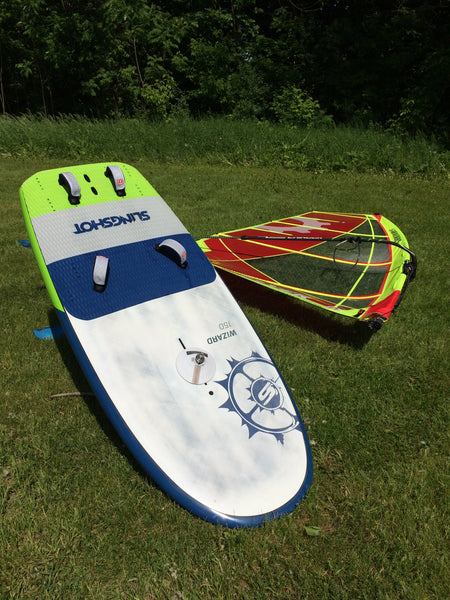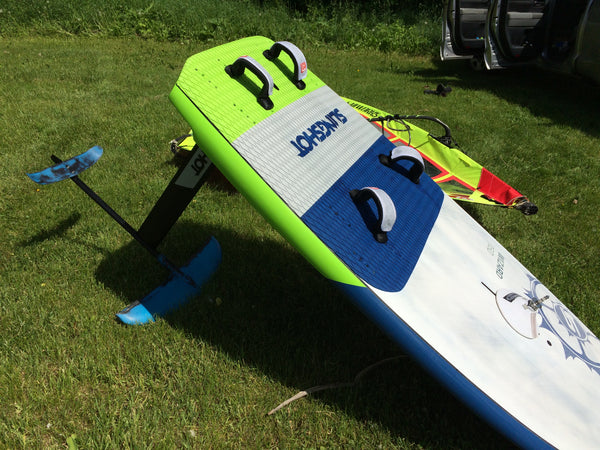Foil Specific Windsurfing Sail Test: Sailworks Flyer and Naish Lift (video)
Shop All Foil Windsurf Sails Here!
We've been intrigued by all things Windsurf Foil lately, so we decided to grab a few Foil Specific Sails to see what all the buzz is about! As we all know, there isn't anything wrong with going foiling with a regular sail, so are these new foil sails worth the investment? And what do they offer that a regular sail doesn't?
We got our hands on a Naish Lift 5.7 and a Sailworks Flyer 7.0, both of which are billed as crazy powerful foiling sails, designed to get you up and running in next to no wind. And although their design intents are quite similar, their shapes and materials couldn't be further apart!
Our first day testing these sails was perfect- super light wind in the 3-10 knot range meant a fair amount of standing around waiting for gusts, and then seeing just how well these sails can get you moving, and how long they'll keep you moving as you coast into a lull. Long story short, we were not disappointed with either sail!
We used a popular freeride foil for our test- the Slingshot HoverGlide Fwind1, which is known to be a middle of the road foil- it is an early flyer with fun mobility and responsiveness, but still has enough speed to keep things interesting. We mounted it on a Slingshot Wizard 150, with footstraps inboard (freeride position), mast track mid-forward, and kept the foil wings in the furthest back (more control, but slightly less lift) position. We kept everything on the board and foil exactly the same while we switched between the sails.
Naish Lift 5.7
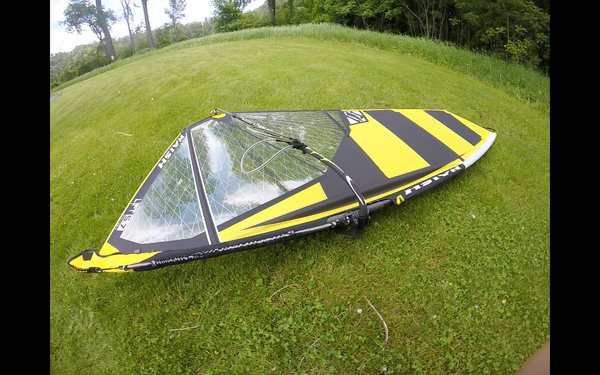
First up, we tried out the Naish Lift 5.7. This is a 3 and a half batten sail with super light dacron upper panels and a thin x-ply in the lower panels. It rigs on a 400 RDM with virtually zero base extension, and has a boom length in the 195 range. The nice thing about these specs is that you can use your regular high wind components to rig it up- no need to buy bigger gear, if you're generally a high wind snob who only owns small stuff!
This sail is insanely light, being mostly dacron and rigging on a short mast. It is also VERY soft, similar to a beginner sail- it goes flat and weightless really easily, and then transitions to a baggy powerhouse as soon as you even think about sheeting in. Add some pumping action and the springiness of the materials and that light short mast seem to magically multiply the sail's square meters, giving this 5.7 the power of a regular... maybe 9.0 race sail??? Tough to say with any exactness, but it is amazing nonetheless!
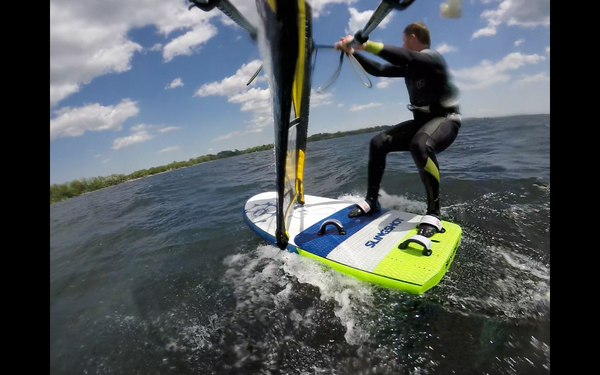
Pump Pump Pump It Up! The light weight of the Naish Lift pumps like a dream!
Your natural stance while using this sail will be quite vertical, and it really lends itself to standing over the foil with a more centered stance, rather than getting way out on the rails. This is consistent with all of the Naish foiling gear, which tends to be narrower in board width and more centered in foot strap position. Once flying, the sail feels crazy light and easy to move around. And despite the soft nature of the sail, it is plenty stable to sheet in and trust the power delivery as you go for higher speeds.
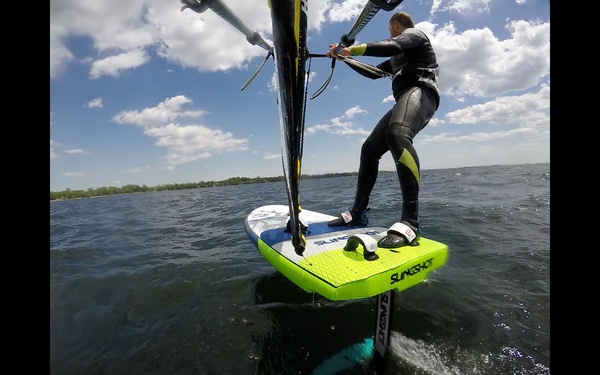
Natural Flying Stance on the Naish Lift- Upright and Centered, light sheeting effort
The Naish Lift is, in our opinion, best suited to early flying wave and freeride foils, and is totally fine while being paired up with boards that are on the narrower side. Riders who are used to soft wave or freestyle sails, and who are practiced in light wind freestyle or SUP sailing (or similar upright stance, low power scenarios) will feel right at home on this sail, and will fall in love with it's crazy light weight and fun, soft feel!
Sailworks Flyer 7.0
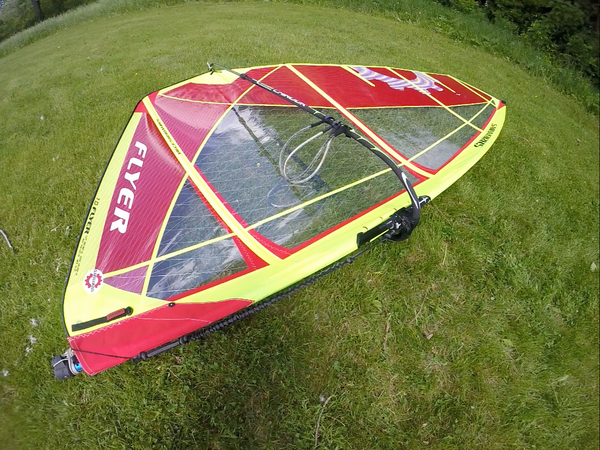
Next up, we tried out the Sailworks Flyer 7.0. This is a full X-ply, 4 batten, twin cam powerhouse! It is quite a bit taller than the Naish Lift, rigging on a fully extended 430 RDM (+32cm base). It requires booms in the 201-205 range. So spec wise, if you're a high wind junkie, just be aware that you may need to get some larger components to make this sail work.
Despite the larger size and needing a longer mast/boom, the Flyer is still insanely light in the hands. The cams lock a nice deep draft into the sail, so it has a great, trustworthy pull in next to no wind. We had no problem getting the cams to rotate, even in 3-5 knot lulls. And then if a 10 knot gust came up, WOW, does the Flyer accelerate and pull like crazy!! Give it a few pumps and you're instantly flying on the foil! And with the locked in shape, you can coast through lulls like they aren't even there.

Pumpity Pumpity- High Clew and gobs of POWER with the Sailworks Flyer!
You'll naturally take a slightly more "powered up" stance with the Flyer- hiking out a bit more, and sheeting in a bit harder. This will allow for more ability to drive hard upwind, go faster, and get your feet a bit further out toward the rails to help control the kit.

Natural Flying Stance on the Sailworks Flyer- Slightly more sheeted in and hiked out stance, powered up feeling
The best part about the Flyer, though? It feels like an old friend. So stable, powerful, and easy, it reminds you of the best freeride sail you ever had. But you're flying along ABOVE the water in just 8-10 knots of wind, not freeriding regular gear on a 15-20 knot day. It is best paired up with moderate width and wider boards, and freeride up to race foils. Riders who enjoy powered up blasting back and forth on regular freeride or slalom gear will feel right at home on the Flyer!
Foil Sails -vs- Regular Sails
On this particular test day, in just 3-10 knot winds, the ability to get up and running with a regular 5.7 or 7.0 would've been quite far fetched, if not impossible. The regular sails are generally built to be sailed while powered up, so they don't normally take a great shape in super light winds. They tend to be built up a bit more, too, with more battens, and sometimes more "heavy duty" materials and stronger reinforcements to help the sails cope with the more extreme conditions. This all adds up to more weight, and less responsiveness in super light wind. Furthermore, regular sails are usually designed with a more powered up stance in mind, so when foiling in light wind, with virtually zero power and an upright stance, sometimes the balance feels off and your body can get "tweaked" while trying to hold the sail in position.
So it seems that the main benefits of the Foil Specific sails are the extremely light weights, and the incredible surge of power that they have in super light winds. The stance is also perfectly dialed in with foil kits, so you always feel balanced and the rig feels like an extension of your body. Pretty sweet!
The Bottom Line
So is it worth it?? Should you go out and buy a foil specific sail? Well, that's up to you. If you're counting your pennies and just want to dip your big toe in the water with foiling, then don't stress it, use your regular sails, and go have fun. You'll never know what you're missing, and you'll have a blast anyway. But if you're the kind of person who likes to optimize their equipment for the conditions, and you're spending a fair amount of time riding a foil, then the simple answer is "Heck Yeah!" The upgrade is amazing, and as we all know, there is no other feeling quite like having the perfectly dialed in kit for the day. You'll never look back!!
Shop All Foil Windsurf Sails Here!


